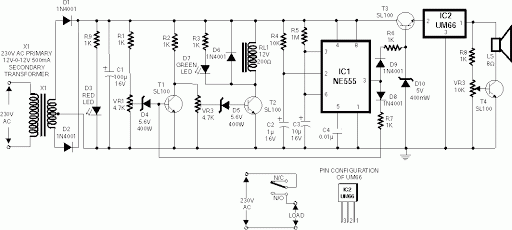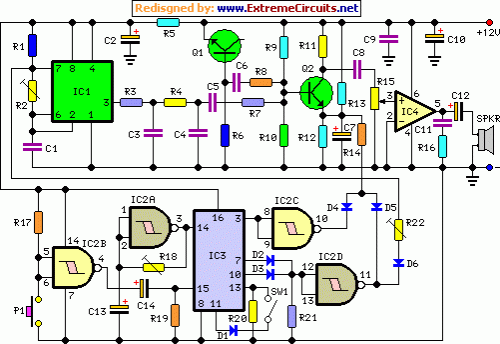
melody generator for

This compact circuit consists of a single three-terminal integrated circuit (IC) UM66, which can be miniaturized enough to fit inside a greeting card, powered by a single 3V flat button cell. The circuit's simplicity is evident; the UM66 is connected to its power supply, and its output is directed to a transistor for amplification. Users can choose between a 4-ohm speaker or a flat piezoelectric tweeter, similar to those used in alarm wristwatches. The UM66 resembles a transistor with three terminals and serves as a complete miniature tone generator, featuring a ROM that stores 64 musical notes, an oscillator, and a preamplifier. Initially, it was programmed to play the tune "Jingle Bells," but it is now available with a wide range of melodies.
The UM66 integrated circuit is designed specifically for generating audio tones in compact applications. It operates on a low voltage, making it suitable for battery-powered devices. The circuit's architecture includes a built-in ROM that contains a selection of melodies, allowing for easy integration into greeting cards and similar products. The output of the UM66 is typically a low-level audio signal, which is insufficient to drive speakers directly. Therefore, a transistor is used to amplify this signal, enabling it to drive either a small speaker or a piezoelectric tweeter effectively.
When selecting a speaker or tweeter, the impedance and power handling must be considered. A 4-ohm speaker is commonly used due to its ability to produce a richer sound, while a piezoelectric tweeter offers a compact alternative with lower power consumption. The choice between these options can affect the audio quality and volume of the output.
The circuit can be easily assembled on a small printed circuit board (PCB) or even on a breadboard for prototyping. Connections to the UM66 include a power supply pin, a ground pin, and an output pin that connects to the base of the transistor. The transistor, typically an NPN type, is used to switch the larger current required by the speaker or tweeter while being controlled by the low-current output from the UM66.
In summary, this circuit exemplifies the integration of sound generation technology into compact consumer products, providing an engaging audio experience in a small form factor. The versatility of the UM66, along with the amplification stage, allows for a range of applications beyond greeting cards, including toys and novelty items, enhancing their interactive features.This tiny circuit comprising of a single 3 terminal IC UM66 can be built small enough to be placed inside a greeting card and operated off a single 3V flat button cell. There is not much to the circuit. The UM66 is connected to its supply and its output fed to a transistor for amplification. You can either use a 4ohm speaker or a " flat" piezoelec tric tweeter like the one found in alarm wrist watches. The UM66 looks like a transistor with 3 terminals. It is a complete miniature tone generator with a ROM of 64 notes, oscillator and a preamplifier. When it first came into market, it was programmed for the "Jingle bells" tune. Now they come with a wide variety of different tunes. 🔗 External reference
The UM66 integrated circuit is designed specifically for generating audio tones in compact applications. It operates on a low voltage, making it suitable for battery-powered devices. The circuit's architecture includes a built-in ROM that contains a selection of melodies, allowing for easy integration into greeting cards and similar products. The output of the UM66 is typically a low-level audio signal, which is insufficient to drive speakers directly. Therefore, a transistor is used to amplify this signal, enabling it to drive either a small speaker or a piezoelectric tweeter effectively.
When selecting a speaker or tweeter, the impedance and power handling must be considered. A 4-ohm speaker is commonly used due to its ability to produce a richer sound, while a piezoelectric tweeter offers a compact alternative with lower power consumption. The choice between these options can affect the audio quality and volume of the output.
The circuit can be easily assembled on a small printed circuit board (PCB) or even on a breadboard for prototyping. Connections to the UM66 include a power supply pin, a ground pin, and an output pin that connects to the base of the transistor. The transistor, typically an NPN type, is used to switch the larger current required by the speaker or tweeter while being controlled by the low-current output from the UM66.
In summary, this circuit exemplifies the integration of sound generation technology into compact consumer products, providing an engaging audio experience in a small form factor. The versatility of the UM66, along with the amplification stage, allows for a range of applications beyond greeting cards, including toys and novelty items, enhancing their interactive features.This tiny circuit comprising of a single 3 terminal IC UM66 can be built small enough to be placed inside a greeting card and operated off a single 3V flat button cell. There is not much to the circuit. The UM66 is connected to its supply and its output fed to a transistor for amplification. You can either use a 4ohm speaker or a " flat" piezoelec tric tweeter like the one found in alarm wrist watches. The UM66 looks like a transistor with 3 terminals. It is a complete miniature tone generator with a ROM of 64 notes, oscillator and a preamplifier. When it first came into market, it was programmed for the "Jingle bells" tune. Now they come with a wide variety of different tunes. 🔗 External reference





